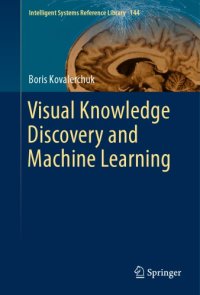
Ebook: Visual Knowledge Discovery and Machine Learning
Author: Kovalerchuk Boris
- Tags: Artificial intelligence, Computational intelligence, Engineering, Ingénierie, Intelligence artificielle, Intelligence informatique, Ingénierie
- Series: Intelligent Systems Reference Library 144
- Year: 2018
- Publisher: Springer International Publishing
- City: Cham
- Language: English
- pdf
3.3 Fixed Single Point Approach3.3.1 Single Point Algorithm; 3.3.2 Statements Based on Single Point Algorithm; 3.3.3 Generalization of a Fixed Point to GLC; 3.4 Theoretical Limits to Preserve n-D Distances in 2-D: Johnson-Lindenstrauss Lemma; 3.5 Visual Representation of n-D Relations in GLC; 3.5.1 Hyper-cubes and Clustering in CPC; 3.5.2 Comparison of Linear Dependencies in PC, CPC and SPC; 3.5.3 Visualization of n-D Linear Functions and Operators in CPC, SPC and PC; References; 4 Adjustable GLCs for Decreasing Occlusion and Pattern Simplification.;This book combines the advantages of high-dimensional data visualization and machine learning in the context of identifying complex n-D data patterns. It vastly expands the class of reversible lossless 2-D and 3-D visualization methods, which preserve the n-D information. This class of visual representations, called the General Lines Coordinates (GLCs), is accompanied by a set of algorithms for n-D data classification, clustering, dimension reduction, and Pareto optimization. The mathematical and theoretical analyses and methodology of GLC are included, and the usefulness of this new approach is demonstrated in multiple case studies. These include the Challenger disaster, world hunger data, health monitoring, image processing, text classification, market forecasts for a currency exchange rate, computer-aided medical diagnostics, and others. As such, the book offers a unique resource for students, researchers, and practitioners in the emerging field of Data Science.;Intro; Preface; Acknowledgements; Contents; List of Abbreviations; Abstract; 1 Motivation, Problems and Approach; 1.1 Motivation; 1.2 Visualization: From n-D Points to 2-D Points; 1.3 Visualization: From n-D Points to 2-D Structures; 1.4 Analysis of Alternatives; 1.5 Approach; References; 2 General Line Coordinates (GLC); 2.1 Reversible General Line Coordinates; 2.1.1 Generalization of Parallel and Radial Coordinates; 2.1.2 n-Gon and Circular Coordinates; 2.1.3 Types of GLC in 2-D and 3-D; 2.1.4 In-Line Coordinates; 2.1.5 Dynamic Coordinates; 2.1.6 Bush and Parallel Coordinates with Shifts.;4.4 Simplifying Patterns by Relocating and Scaling Circular and n-Gon Coordinates4.5 Decreasing Occlusion with the Expanding and Shrinking Datasets; 4.5.1 Expansion Alternatives; 4.5.2 Rules and Classification Accuracy for Vicinity in E1; 4.6 Case Studies for the Expansion E1; 4.7 Discussion; References; 5 GLC Case Studies; 5.1 Case Study 1: Glass Processing with CPC, APC and SPC; 5.2 Case Study 2: Simulated Data with PC and CPC; 5.3 Case Study 3: World Hunger Data; 5.4 Case Study 4: Challenger USA Space Shuttle Disaster with PC and CPC.;2.2 Reversible Paired Coordinates2.2.1 Paired Orthogonal Coordinates; 2.2.2 Paired Coordinates with Non-linear Scaling; 2.2.3 Partially Collocated and Non-orthogonal Collocated Coordinates; 2.2.4 Paired Radial (Star) Coordinates; 2.2.5 Paired Elliptical Coordinates; 2.2.6 Open and Closed Paired Crown Coordinates; 2.2.7 Clutter Suppressing in Paired Coordinates; 2.3 Discussion on Reversible and Non-reversible Visualization Methods; References; 3 Theoretical and Mathematical Basis of GLC; 3.1 Graphs in General Line Coordinates; 3.2 Steps and Properties of Graph Construction Algorithms.;4.1 Decreasing Occlusion by Shifting and Disconnecting Radial Coordinates4.2 Simplifying Patterns by Relocating and Scaling Parallel Coordinates; 4.2.1 Shifting and Tilting Parallel Coordinates; 4.2.2 Shifting and Reordering of Parallel Coordinates; 4.3 Simplifying Patterns and Decreasing Occlusion by Relocating, Reordering, and Negating Shifted Paired Coordinates; 4.3.1 Negating Shifted Paired Coordinates for Removing Crossings; 4.3.2 Relocating Shifted Paired Coordinates for Making the Straight Horizontal Lines; 4.3.3 Relocating Shifted Paired Coordinates for Making a Single 2-D Point.
Download the book Visual Knowledge Discovery and Machine Learning for free or read online
Continue reading on any device:

Last viewed books
Related books
{related-news}
Comments (0)